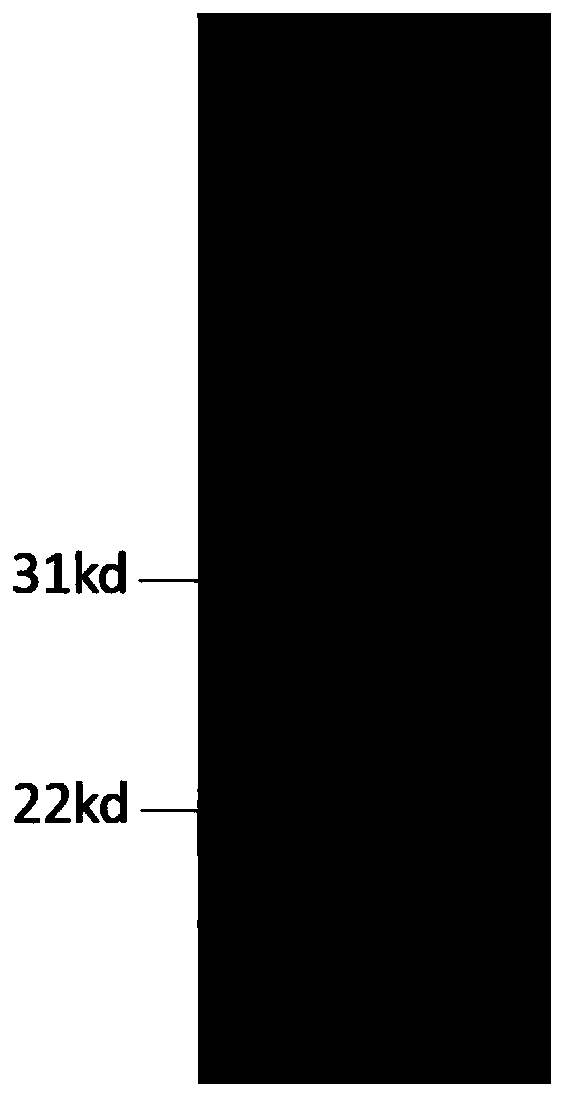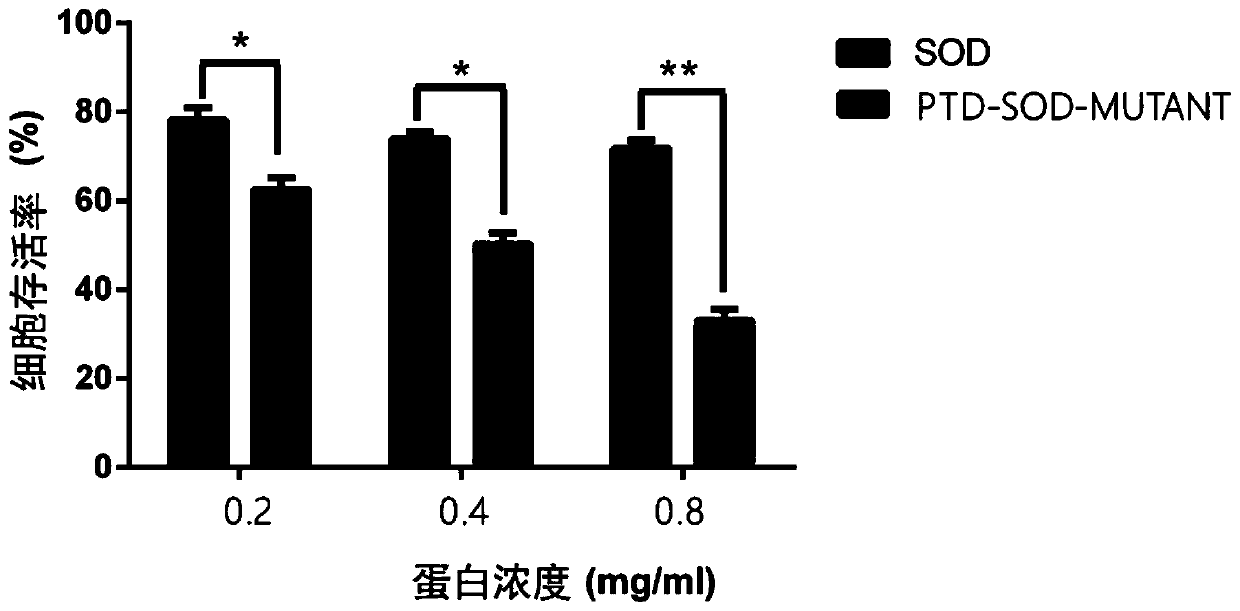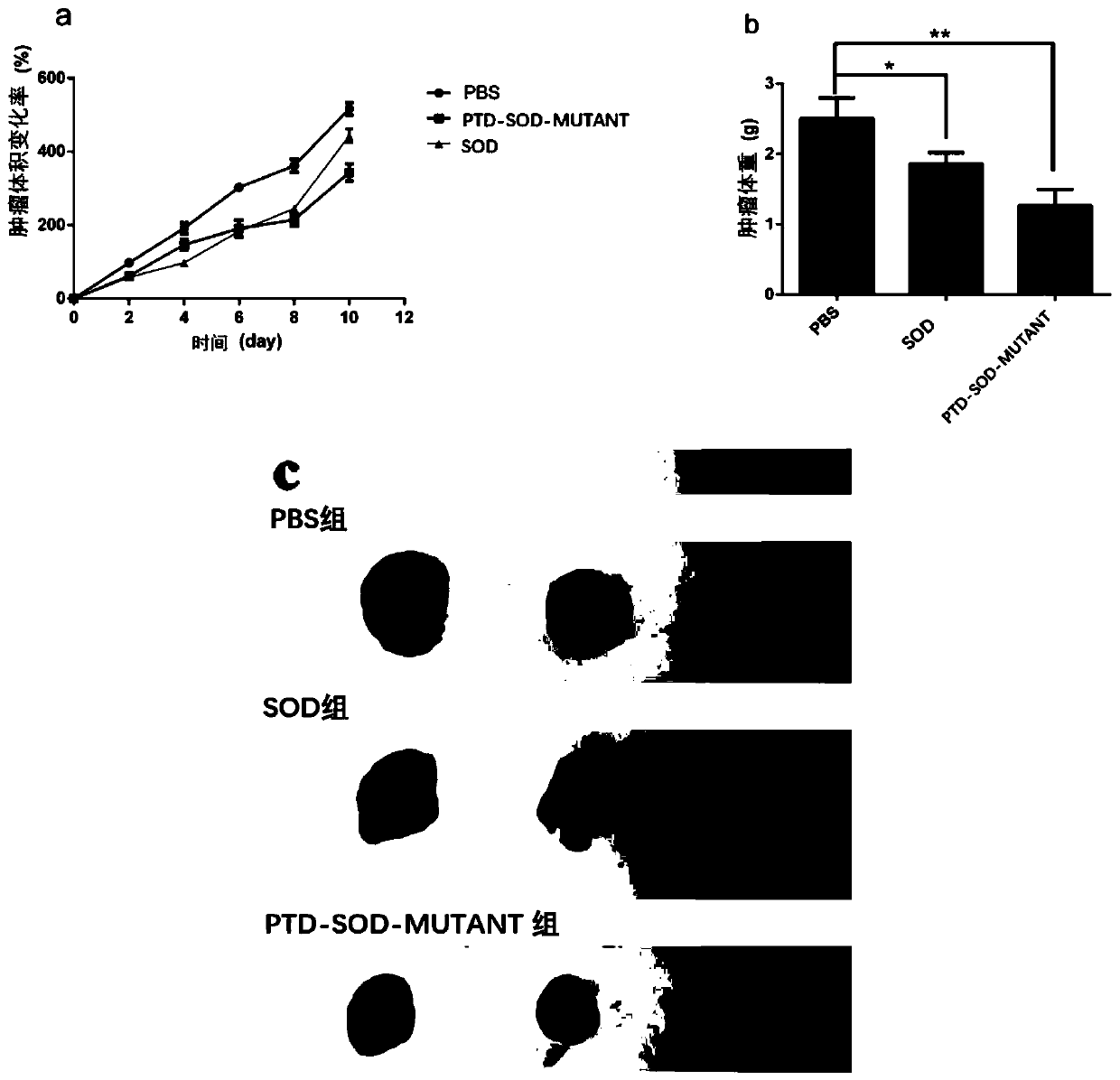High-temperature-resistant mutant SOD with PTD and encoding gene and application thereof
A PTD-SOD-MUTANT, encoding gene technology, applied in application, genetic engineering, plant genetic improvement, etc., can solve the problems of limited SOD application, poor thermal stability, and no specific receptors in cell membranes
- Summary
- Abstract
- Description
- Claims
- Application Information
AI Technical Summary
Problems solved by technology
Method used
Image
Examples
Embodiment 1
[0049] Expression and purification of PTD-SOD-MUTANT protein
[0050] The PTD-SOD-MUTANT gene sequence was synthesized by Sangon Bioengineering Shanghai (Co., Ltd.), and the prokaryotic expression vector was pet28b. Transform the recombinant plasmid into competent Escherichia coli BL21(DE3) by heat shock method, add isopropyl-β-D-thiogalactopyranoside (IPTG) for shaker culture, and induce PTD-SOD-MUTANT protein For expression, the shaker speed is 220rpm / min (rotation speed range 200-250rpm / min, preferably 220rpm / min), the induction temperature is 37°C (induction temperature range is 30-38°C, preferably 37°C), and the final concentration of IPTG is 1mM (IPTG The final concentration range is 0.1-1.5mM, preferably 1mM), and the induction time is 7 hours (the induction time range is 3-8h, preferably 7h). The bacteria after induced expression were treated by ultrasonic lysis, and the PTD-SOD-MUTANT protein was purified by adding Washing Buffer with an imidazole concentration of 25...
Embodiment 2
[0052] Inhibitory effect of PTD-SOD-MUTANT protein on mouse B16 melanoma cell proliferation in vitro
[0053] The effect of PTD-SOD-MUTANT protein and SOD protein (control) on the proliferation of mouse B16 melanoma cells was detected by MTT method. The principle of MTT method: succinate dehydrogenase in the mitochondria of living cells can reduce exogenous MTT to insoluble blue-purple crystals and deposit them in cells, while dead cells have no such function. Dimethyl sulfoxide (DMSO) can dissolve purple crystals in cells, and the light absorption value is measured at a wavelength of 570nm with a microplate reader, which can indirectly reflect the number of living cells.
[0054] The specific operation is as follows: take mouse B16 melanoma cells in the logarithmic growth phase, inoculate them into 96-well plates, and the number of cells per well is 1×10 3 ;Set the treatment groups for the two proteins according to three gradients of 0.2, 0.4, and 0.8 mg / mL, with 3 auxiliary...
Embodiment 3
[0057] In vivo therapeutic effect of PTD-SOD-MUTANT protein on malignant melanoma in mice
[0058] The mouse B16 melanoma cells in the logarithmic growth phase were taken, the culture fluid was aspirated, digested with trypsin and counted. Centrifuge at 1000rpm for 5 minutes, make a cell suspension with DMEM culture medium, and adjust the cell concentration to 1×10 6 individual / mL. Nine healthy purebred nude mice aged 4-6 weeks were injected with 0.1 mL of prepared tumor cell suspension in the left armpit, and repeated on the second day. The body weight of the nude mice was measured every 2 days, and the basic vital characteristics were observed. The growth of tumors in the axilla of the nude mice indicated that the modeling was successful. Every 2 days, the tumor diameter was measured with a vernier caliper. When the tumor diameter was about 1 cm, the animals were randomly divided into 3 groups, and 0.1 ml of PBS, PTD-SOD-MUTANT protein (concentration 0.8 mg / mL), SOD protei...
PUM
 Login to View More
Login to View More Abstract
Description
Claims
Application Information
 Login to View More
Login to View More - R&D
- Intellectual Property
- Life Sciences
- Materials
- Tech Scout
- Unparalleled Data Quality
- Higher Quality Content
- 60% Fewer Hallucinations
Browse by: Latest US Patents, China's latest patents, Technical Efficacy Thesaurus, Application Domain, Technology Topic, Popular Technical Reports.
© 2025 PatSnap. All rights reserved.Legal|Privacy policy|Modern Slavery Act Transparency Statement|Sitemap|About US| Contact US: help@patsnap.com



